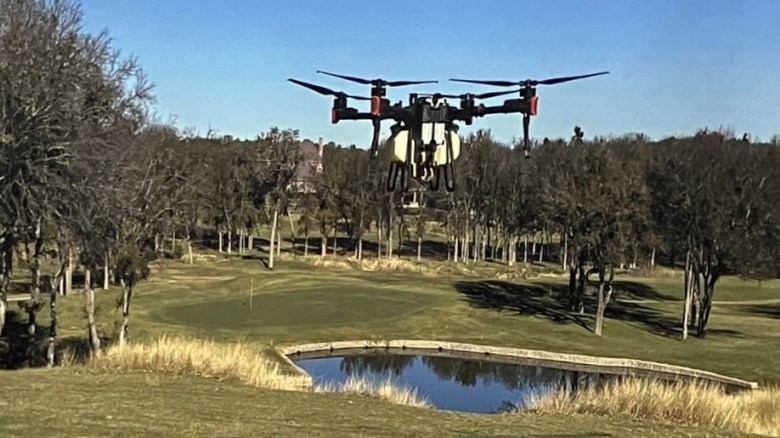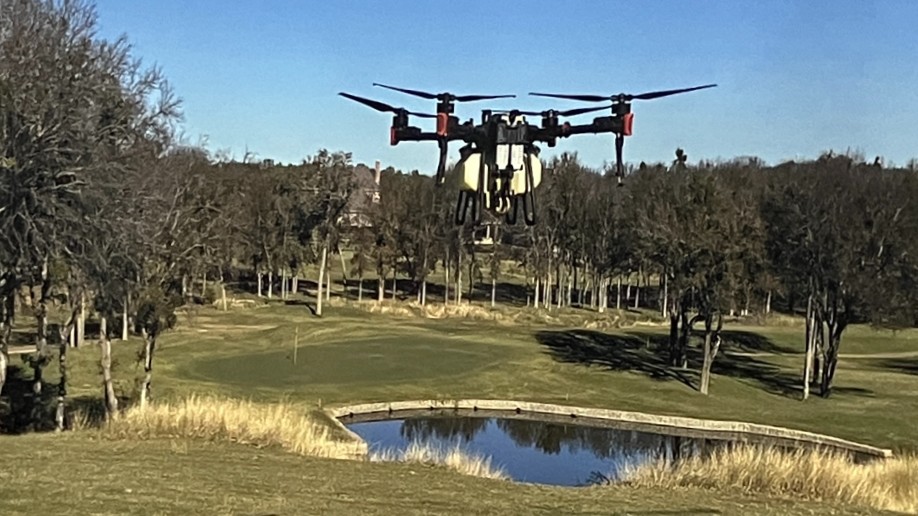 A maintenance drone inspects a golf course. (Photo of exhibit display)
A maintenance drone inspects a golf course. (Photo of exhibit display)
The use of aerial drones in the care and feeding of golf courses was one of the cutting-edge technologies on display at a recent convention of golf course managers in San Diego. But the gathering wasn’t all about 21st century tech.
In sharp contrast were the young border collies being trained in skills that were in use before the first round of golf was played in the 15th century.
The convention center’s exhibit floor was filled with mowers, fertilizers, irrigation systems, and just about everything and anything to do with keeping the turf and sand on a golf course in great playing shape. A big focus was keeping golf courses healthy in the face of climate change, including irrigating landscapes efficiently, and sustainable strategies for care and maintenance of the turf.
The Golf Course Superintendents Association of America gathering, which wrapped up earlier this month, drew not only superintendents, but manufacturers and experts in golf landscapes. In all, there were about 11,000 attendees from across the U.S. and around the world, from Egypt to Japan. The GCSAA’s first convention in San Diego was in 1963.
A favorite among attendees were the drone exhibits area that included numerous vendors offering airborne maintenance options for courses. One exhibitor, Turf Logic, had on display about a dozen different drone types. Videos showed drones with special sensors flying low across a golf course being used to measure the stress the turf undergoes on tees, fairways and greens.
“One square inch at a time” is how Andrew Terry of Turf Logic explains it. The company began 15 years ago, using drones initially for video production, then moving into public safety and law enforcement and finally into the power industry and telecom. “And then we broke into the turf industry,” he says
“We’re working with the Aztecs football team at Snapdragon Stadium,” he said. “I know they just got out of their Monster Jam at the end of the year, the turf taking more of a beating than any sort of golf could take.”
Golf courses are a different creature, he explained. “The stress they’re experiencing is not football players in cleats and turf,” he says. “It’s a much bigger problem than a two-acre parcel of turf like Snapdragon and a lot of different stresses they experience.”
The company sells the idea of first doing a digital “picture” of all features on the golf course by using a drone. A laser scanner on board the drone emits pulses of light at a target, it measures the exact distances between the laser and target to create a 3D model of the golf course’s surface. But Terry says the work doesn’t end there.
“Agronomy professionals know that simply having aerial imagery is not enough,” he says.
More information is needed, so the company uses what’s called “normalized difference vegetation index,” which is based on satellite imagery to measure differences in vegetation health. It’s already used in agriculture to identify stress areas, to monitor crop health, and in environmental monitoring to track vegetation changes due to climate change, drought or deforestation.
A drone is chosen, which is appropriate for a particular golf course, then a course employee will be guided in acquiring a remote pilot certificate as required by the FAA.
“Then they upload their data after every flight into our platform, and we help them with turf stress and manage their stress around the course,” Terry says.
There were more than 400 other exhibitors who offered a seemingly endless variety of golf course must-haves, like all shapes and sizes of signs such as “no carts” and “first tee this way.”
Two of the more intriguing products were “Strike Guard,” a lighting warning system — siren included — and Nano Oxygen Systems, whose creator is Ron Post, a chemical engineer and biologist. The system pumps ultrafine oxygen bubbles into a pond, lake or irrigation system. The bubbles don’t float up in the water, instead they fill the lake or pond. What results are reductions in the amount of fertilizer, fungicides and chemicals used.
“It gets roots to really grow deeply and healthy,” Post says. The research to create the Nano was done at Clemson University. So far, it’s in use at courses in New York, Florida, Colorado and Arizona.
At the end of the convention hall, a crowd of adults and kids had gathered three deep around a white picket fence, which marked a corral with dogs, border collies, and ducks inside running around as if on a mission. The ringmaster was Rebecca Gibson of Fly Away Geese, out of North Carolina.
She explains the collies undergo training from six months to a year to learn how to motivate the ducks to move along. As she encouraged the dogs through their duck tracking, the crowd laughed and clapped in appreciation.
“The dogs represent a wolf or coyote,” says Gibson, “but they have no kill instinct and no desire to harm the birds. So no harm comes to the birds when the dogs are working, they just get convinced it’s not a safe place to be.”
If you’ve ever seen a sheep dog corralling sheep, this is the same sort of behavior, with the collies shooing away geese and other birds who are often unwelcome on golf courses and elsewhere.
For the past two years one of her trained border collies has been working at San Bernardino Airport to address ravens on the runway. Bird strikes can be deadly to aircraft, so the collie is a safety measure for pilots.
Gibson adds, “We’re one of the only forms of wildlife management that’s approved by PETA and the Humane Society.” She says they are “big proponents and pushers of using the border collies because it is a non-invasive, non-lethal means of management.”
She has a degree in classical vocal performance, and uses high-pitched whistles to direct the dogs she’s training to obey her commands.
“I bought a border collie when I was pregnant with my first daughter, and started doing sheepdog trials,” she says. But It wasn’t until a golf course maintenance person had an idea for dealing with goose problems on a New Jersey golf course that the industry was born.
How much does a trained goose chaser cost? It’s $7,500 to $10,000, but a bargain for a golf course she says.
“A goose eats four pounds of grass a day and two square feet of grass a day. So if it costs them $1.50 to replace that grass, then every bird on their golf course costs them $3 a day,” she says, pointing out that It doesn’t take long to pay for the border collie.
And the golfers using the course appreciate not being distracted by noisy geese or having to clean duck poop off their golf balls.






